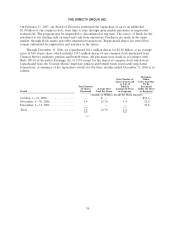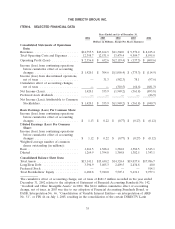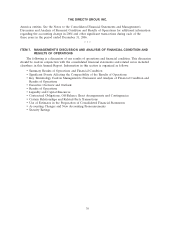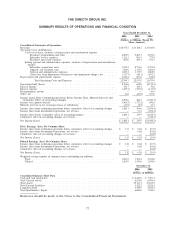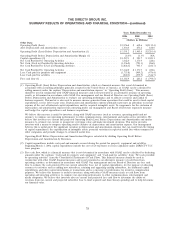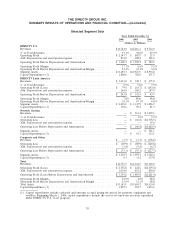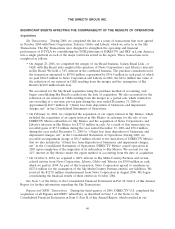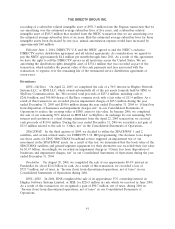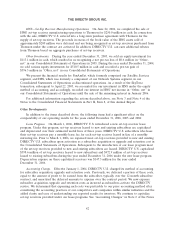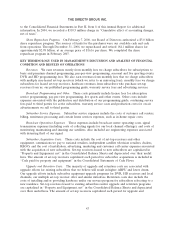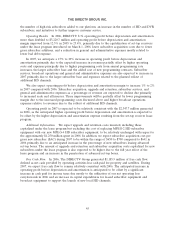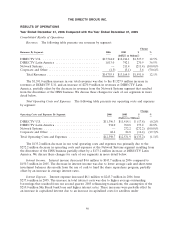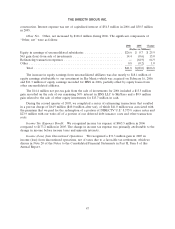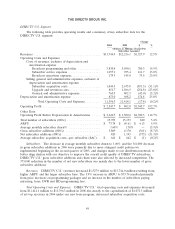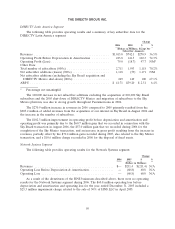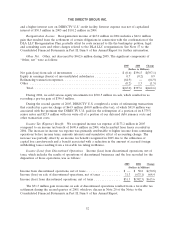DIRECTV 2006 Annual Report Download - page 54
Download and view the complete annual report
Please find page 54 of the 2006 DIRECTV annual report below. You can navigate through the pages in the report by either clicking on the pages listed below, or by using the keyword search tool below to find specific information within the annual report.THE DIRECTV GROUP, INC.
to the Consolidated Financial Statements in Part II, Item 8 of this Annual Report for additional
information. In 2004, we recorded a $310.5 million charge in ‘‘Cumulative effect of accounting changes,
net of taxes’’.
Share Repurchase Program. On February 7, 2006, our Board of Directors authorized a $3.0 billion
share repurchase program. The sources of funds for the purchases were our available cash and cash
from operations. Through December 31, 2006, we repurchased and retired 184.1 million shares for
approximately $2.98 billion, at an average price of $16.16 per share. We completed the share
repurchase program in February 2007.
KEY TERMINOLOGY USED IN MANAGEMENT’S DISCUSSION AND ANALYSIS OF FINANCIAL
CONDITION AND RESULTS OF OPERATIONS
Revenues. We earn revenues mostly from monthly fees we charge subscribers for subscriptions to
basic and premium channel programming, pay-per-view programming, seasonal and live sporting events,
DVR and HD programming fees. We also earn revenues from monthly fees that we charge subscribers
with multiple non-leased set-top receivers (which we refer to as mirroring fees), monthly fees we charge
subscribers for leased set-top receivers, hardware revenues from subscribers who purchase set-top
receivers from us, our published programming guide, warranty service fees and advertising services.
Broadcast Programming and Other. These costs primarily include license fees for subscription
service programming, pay-per-view programming, live sports and other events. Other costs include
expenses associated with the publication and distribution of our programming guide, continuing service
fees paid to third parties for active subscribers, warranty service costs and production costs for on-air
advertisements we sell to third parties.
Subscriber Service Expenses. Subscriber service expenses include the costs of customer call centers,
billing, remittance processing and certain home services expenses, such as in-home repair costs.
Broadcast Operations Expenses. These expenses include broadcast center operating costs, signal
transmission expenses (including costs of collecting signals for our local channel offerings), and costs of
monitoring, maintaining and insuring our satellites. Also included are engineering expenses associated
with deterring theft of our signal.
Subscriber Acquisition Costs. These costs include the cost of set-top receivers and other
equipment, commissions we pay to national retailers, independent satellite television retailers, dealers,
RBOCs and the cost of installation, advertising, marketing and customer call center expenses associated
with the acquisition of new subscribers. Set-top receivers leased to new subscribers are capitalized in
‘‘Property and Equipment, net’’ in the Consolidated Balance Sheets and depreciated over their useful
lives. The amount of set-top receivers capitalized each period for subscriber acquisitions is included in
‘‘Cash paid for property and equipment’’ in the Consolidated Statements of Cash Flows.
Upgrade and Retention Costs. The majority of upgrade and retention costs are associated with
upgrade efforts for existing subscribers that we believe will result in higher ARPU and lower churn.
Our upgrade efforts include subscriber equipment upgrade programs for DVR, HD receivers and local
channels, our multiple set-top receiver offer and similar initiatives. Retention costs also include the
costs of installing and/or providing hardware under our movers program for subscribers relocating to a
new residence. Set-top receivers leased to existing subscribers under upgrade and retention programs
are capitalized in ‘‘Property and Equipment, net’’ in the Consolidated Balance Sheets and depreciated
over their useful lives. The amount of set-top receivers capitalized each period for upgrade and
43



